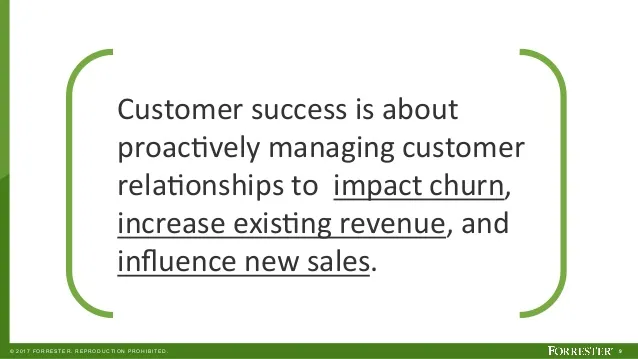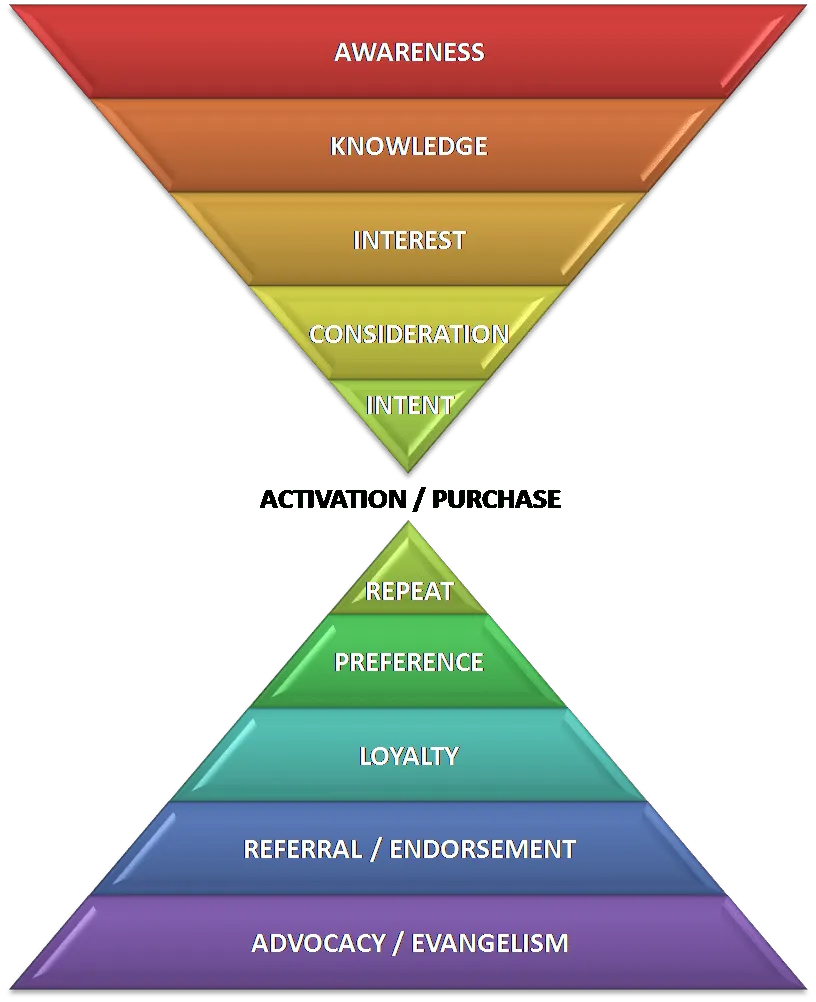Customer Success Tactics That Lead to Hyper Growth

Customer success means establishing a relationship with your clients, listening and understanding what their needs are and supporting them throughout the journey that leads to their own goals. That’s all nice and clear in theory but what are some actionable customer success tactics that actually work?
It’s easy to get lost in the fluff and talk about general concepts but, when it comes to customer success, it’s important to have a clear strategy in mind and put in place effective measures that actually have an impact on the customer journey. A well defined customer success playbook is in fact vital in order to guarantee a constant customer success driven growth.
Source
Basic elements of a solid customer success program are competence, a strategic plan, a centralized repository to store all the information you collect at different stages of the customer journey, consistency, and proper tools to listen, collect feedback, create a feedback loop and optimize the strategy.
There are companies out there that truly rock customer success and by looking at what has proven to be effective for them, we created a short list of tactics that are sure to boost your customer success results.
Table of Contents
Drafting a Customer Success Strategy
All the tactics you implement in your customer success program should be aligned with an overall customer success strategy.
In order to develop a strategy you need to define specific customer segments and understand what goals each of your customer needs to achieve and how through the interaction with your brand and product.
Even if multiple customers share a desired outcome in a segment, it is important to create a tailored and individual experience for each of them.

Based on desired outcomes and individual experience it’s possible to create a roadmap that includes specific targets (milestones) and decide on all the elements (people, content, technology…) that need to be out in place to create a perfect journey that leads from onboarding to success and advocacy.
The overall strategy applies to single segments, based on outcomes but the set of tactics, tools and skills required to create individual plans vary from client to client.
Proven Customer Success Tactics that Work
Before we start with our list, it’s important to remember that even though certain tactics and techniques seem to be valuable for a few companies, your customer success management program is specific to your line of business and to your clients.
Therefore, it would be unreasonable to treat certain activities as standards. There’s no silver bullet!
Apart from this caveat, it is worth checking what customer success tactics have been successfully implemented by other companies to maybe find some inspiration.

Onboarding and User Adoption
Highlight Benefits, not Features
The truth is that no matter how many sleepless nights you spent creating a great product roadmap, users are not interest in your product’s features. Users only care about one thing: outcome!
When presenting features to your users don’t focus on characteristics. You need to focus on the results. People don’t work with your product to enjoy its features, they use a product because they have a picture in mind of how their current situation should improve with it.
Imagine you need to convince an employee to work longer hours to meet a tight deadline. You’ll never tell them “Look, we need to work a little longer on this, but you’ll get rewarded for overtime with green bills with a depiction of a great president. New material! Very robust but lightweight. Lots of shades of green and big numbers…” You’ll obviously go for something like: “I know, it’s a tall order but with the bonus and the extra time off you’ll get you’ll be able to spend more time with your family on vacation and relax…” or “if the project is successful we’ll be able to expand your division and you’ll be in charge of it.”
People look for a better version of themselves. For the same reason people aren’t interested in how robust or colorful money is, users aren’t interested in how cool the new features of your products are.
In order to make sure that users look into new features and spend time engaging with your product you need to talk about outcomes and how their situation will improve by investing some time in discovering your product.
Push Users to Doing Things
Big presentations, video tutorials, and documentation delay engagement.
Don’t focus too much on the learning process. Lead users to engaging with the product as soon as possible instead. Learn more about employee training and support is a precious ally. If you concentrate too much on teaching everything about your product with asynchronous tutorials instead of guiding people directly within the software in order to achieve quick wins as soon as possible, you’ll delay engagement.
People have a limited attention span and aren’t interested in spending time in learning something that may not even be useful.
The sooner a user sees results the more likely they’ll be to keep engaging with the product.
Provide a Visible Checklist
People hate unchecked list items. When onboarding new users, make sure that they know all the steps they need to go through in order to achieve first results with your product.
Gamification elements (such as emotional rewards or actual rewards such as unlocking new features) can help users move quickly through the list of activities they need to perform in order to set up the environment properly to accomplish their first tasks.
In this case, a Learn more about employee training and support can help visualize this list of elements that users need to go through in the form of onscreen tours they need to complete to reach their goal.
Tracking progress and rewarding completion will allow you to increase engagement!

Communicate with Users Individually
We deal with an awful amount of new software every day. Investing time in learning each new platform is time-consuming and highly unproductive.
Users who feel guided during onboarding are more likely to go through the entire process.
Imagine I give you a Rubik’s cube and tell you how rewarding and fun it is to solve it. Once I convince you I then leave the room and send you a couple of links to Youtube videos that teach you how to solve it. Now you’re sitting there alone and you open the videos. Even if I managed to persuade you about the fact that solving the cube will make you a better person, will you spend one hour of your time alone watching videos and trying to solve the puzzle all by yourself afterwards?
Probably not. But what if I sit next to you and we go through all the steps together and you end up with a solved cube in your hand in a very short time? How would you feel in that case?
Guiding your users individually is possible..even at scale.
Again, Learn more about employee training and support allow you to walk users through all the processes interactively and comment on each step while rewarding them individually.
Additionally, you can also schedule specific onboarding webinars so that people can interact with you, ask questions and achieve their goals with your product as soon as possible.
Offer Personalized Reports
Personalization plays a key role in modern transactions. The entire customer experience needs to be personalized and users need to monitor their situation and the progress they’re making.
Keep reminding users of all the milestones they covered at each step and what results they accomplished. Adoption reports and dashboards are useful to visualize achievements.
The process can be reinforced with email communication as well.
Make sure you tie each achievement to a solution of an everyday problem users face.
People feel good about their achievements and if you also encourage and facilitate sharing you’ll be able to create a loop that leads to reinforcement.
Connect single achievements to success stories as well so that your users feel compelled to keep going through.

Intervene
If a user seems to be stuck it’s time to intervene.
Ask questions. Try to understand why they stopped the process. Monitor their behavior and offer to help.
You can send reminders that pinpoint all the elements which are missing or steps which haven’t been completed and offer support (we noticed you didn’t do X yet…if you want we can do it for you).
Collect feedback and come up with a tailored solution.
Activation
Habit Formation
Make sure you implement clear elements that lead to habit formation. Mobile app games use push notifications and rewards to make sure that you go back every day for at least a week to create a habit in your daily routine.
You can do the same with emails or even better with phone calls. You need to introduce new elements and rewards on a daily basis (monetary rewards can also help e.g. discounts, free additional users, free content if you accomplish a certain task everyday…) to convince people to go back to your platform and continue their journey.
If users see that every time they go back to your product something new unfolds and they see new results they’ll be more likely to reserve a time slot to check in.
Create daily quests and follow your users throughout the journey! People are tuned to look for novelty elements.

Content and Support
Your product is just one tiny element in a complex ecosystem that your users are setting up to reach their goals.
Make sure you know what these goals are and how your product fits in the big picture.
Then, offer support and educational content to make sure that the whole machine works like a clockwork. Ebooks, presentations, or even better, live webinars on topics which are connected to the challenges your users face must remind them that you’re now a partner not a vendor!
You’re on the same boat now.
Make sure that your users know that they didn’t just purchased access to a piece of software but that they just acquired a whole team of customer success managers, product managers, engineers, project managers and business developers that from now on will work side by side with them towards their goals!
Check-in Calls
Follow your customers at the beginning of their journey. Try to offer help and make sure that they’re actually following all the right steps to move on with your product.
Offering individual check-in calls can be hard to scale and it can also be counter-productive if the customer doesn’t like phone calls in general. Plus, constant contact might also create more overhead and reduce productivity.
Make sure that the client is aware of the opportunity and try to offer different channels for establishing a continuous dialogue.

Perks
Offer specific perks to your customers in exchange for continuous engagement. Create some form of virtual currency you can use for rewarding active users.
Free promotion for their service, content, collaboration, free tools and services, gated communities (on Slack for example) individual assessments, free services…
You can make users feel part of your world and create a series of activities that will add value to your product and contribute to their success.
Churn Prevention
Successful customers who quickly engage with your products and feel supported in their own strategy immediately perceive the added value linked to a collaboration with you.
This leads to a much lower churn rate because immediate effects on their daily work generated through the interaction with your product and brand are visible. Nonetheless, there are other tactics that can be put in place.
Set Reasonable Expectations
Marketing and sales people have the tendency to push the envelope when setting expectations. Not delivering on a promise, though, leads to frustration.
Make sure that nobody in your team overpromises on the potential outcomes. Make sure that your product team, marketing team and sales team are aligned. Their awareness of what the product can or cannot deliver is essential. From copywriting to sales calls and onboarding you need to set the right expectations…or even lower than that so that you have room to surprise your customers by over-delivering and allow them to move from satisfaction to delight!
Take Users by the Hand
Learn more about employee training and support are beneficial in terms of customer retention as well. During the onboarding phase you set the tone for the relationship with your customer.
You need to be fully in control of what happens during this delicate phase and with guidance you can make sure that users go through the correct order of processes to clearly understand what your product can do for them and how they can quickly achieve results.
The first impression counts! A lot!
Frustration or delays during the onboarding phase will create negative feelings which will indelibly be associated to your brand.

Walk in Your Customer’s Shoes and Ask for Feedback
Your solution and the whole customer journey should be designed to address specific pains in an optimal way.
Your product is the result of observations (problem), design (solution) and passion (perfection).
The customer experience you created may be optimal to match your own processes, but you need to be aware that your customers may come from a very different place.
Keep monitoring their behavior and ask for feedback to continuously optimize adoption and implementation according to their needs.
Through educational content and product releases you can show that you actually care and that your customer’s voice is always heard.
Never Stop Selling
People are emotional beings. They need support when they make “rational” decisions but they also need to be constantly reminded that they made the right choice.
As mentioned, reports and dashboards are very useful. Show how many hours of work they saved by using your solution (and show them what they can do with the extra time!) or monitor results (ROI) form them to confirm their choice to work with you.
Underline your competitive advantages and unique selling points to make sure they understand that your competitor is not going to offer them a better solution.
Invest in your relationship. When you get married you may tend to think that the hard work is done, the battle is won. Neglecting your spouse, though, leads to deterioration and your special bond turns into a nightmare when two people simply take different directions without taking care of each other and nurturing their relation.
Adapt to Changes
Your product will never be perfect or even complete.
Each release is a temporary MVP. Deal with it!
At the same time, though, make sure that your customers receive the best experience at each stage. Minor compromises might be necessary but point out where your product roadmap is leading you and deliver on your promises.
You can’t retain customer on intentions!
Deliver the best possible solution at each point in time, show where you’re going and adapt your product to the market in continuous steps.
Customers can be patient if they’re sure you’re working on making things better. But they also need a working solution at each step.
Monitor KPIs and Identify Signals
Customer satisfaction scores and customer success metrics, together with VOC solutions and social listening provide great insights into your customer health.
Be sure you put in place proactive measures to prevent dissatisfaction and reactive solutions to curb the damage.
Great customer support can often prevent churn. Lots of customers who were previously unhappy turn into brand evangelists after they find out that there’s always a reliable parachute in the cockpit!
And if there’s nothing you can do, make sure to collect precious information on why a customer churned.
You need to identify your strengths and weaknesses to position and present your product in a better way!

Brand Advocacy
Successful customers are an eternal source of referrals. Invest time and resources in creating an honest relationship with them and they’ll see that you actually care about their results.
People are likely to share their achievements but it is important to facilitate the process with specific tactics.
Differentiation
Create proper communication that sets your brand apart. Nobody becomes a fan of a no-name, indistinguishable and undefined product.
Create a personality, show your true colors and let people identify with your brand and be part of a whole new world.
Don’t engineer a brand personality with the purpose to resonate with your customers. The process goes the other way around. Let your brand personality develop and attract customer who resonate with it!
Be genuine and don’t try to please everybody. Your customers are your community. They will support you.
Leverage Differentiated Drivers
A wishy washy brand sends mixed signals that don’t generate interest. Let you customers transform your brand. Listen, adapt, and interact with them.
Identify your main brand advocacy drivers and create a consistent communication throughout the journey.
Ask for Support at the right Time
I noticed that one of the game apps I use more often tends to show full screen ads only when I complete a level with 3/3 stars. Coincidence? Not really…
There are three distinct situations in a game:
- You fail miserably. No sense of achievement. You might feel a little frustrated but you know you need to practice more in order to pass the level or achieve a better score.
- You win! Sense of achievement. Positive feeling. More self-confidence. Happy feelings…you’re open to new challenges and experiences.
- Near win. You were soooo close to a perfect score or to the solution of a problem but failed at the last minute. Worst state of mind ever! It’s the silver medal effect: studies showed that bronze medal winners (or people who didn’t even make it to the podium) feel less frustrated than silver medal winners. Why? Because they just didn’t manage to win. Period. A near win creates expectations that lead to greater frustration. But near wins also create champions: people who overcome the frustration and go back to the game as soon as possible. Perseverance separates champions from amateurs.
The best time to show an ad is after situation number two of course. And the worst time would be after situation number three when you just want to go back to the game as soon as possible to prove yourself you can make it!
The best time to ask for support from your customers is after helping them solve a problem. Satisfied customers don’t need to focus on their problem anymore and they’re happy because you helped them along the way and therefore, they’ll be more prone to drop a review, a testimonial, refer your business to their peers and so on.

Enable and Facilitate Advocacy
Customer loyalty and partnership programs can be useful to enable advocacy. Referral programs can turn customers into partners and reinforce your relationship with them especially if your growth also effects the level of service you can offer.
Personalized services and key account management can also spawn advocacy and create endorsers.
You can also exchange content or other form of virtual currency for testimonials or referrals and create all sorts of incentives for reviews and for sharing content: from free promotion to contests, industry trade show tickets or bundled products.
Customer Success is about Human Interaction
No matter what tactics you adopt. The most important element of a customer success program is the human being who listens to the customers, reads their messages, interprets the data you collect, and fosters the relationship with your customers.
Fancy tools and measures can bring you up to a certain point, but customer success tactics that work and lead to hyper-growth are those that involve a certain level of human touch.
We’re always less likely to enter a brick and mortar store and be consulted by a sales person. But that doesn’t mean that we only want to interact with machines and big data analytic tools!
Keep it human….keep it real!
Try Us Out
As underlined a few times in this article, in-software guidance is a precious tool that leads to higher conversion, engagement, activation, and retention. This makes Userlane the best companion of your customer success program.
We’re adamant about that. And we’re very passionate about our mission.
Schedule a demo today with us and talk to people who truly care about your success. Test Userlane for free and enjoy our extraordinary customer success program today!
Learn more about employee training and support

